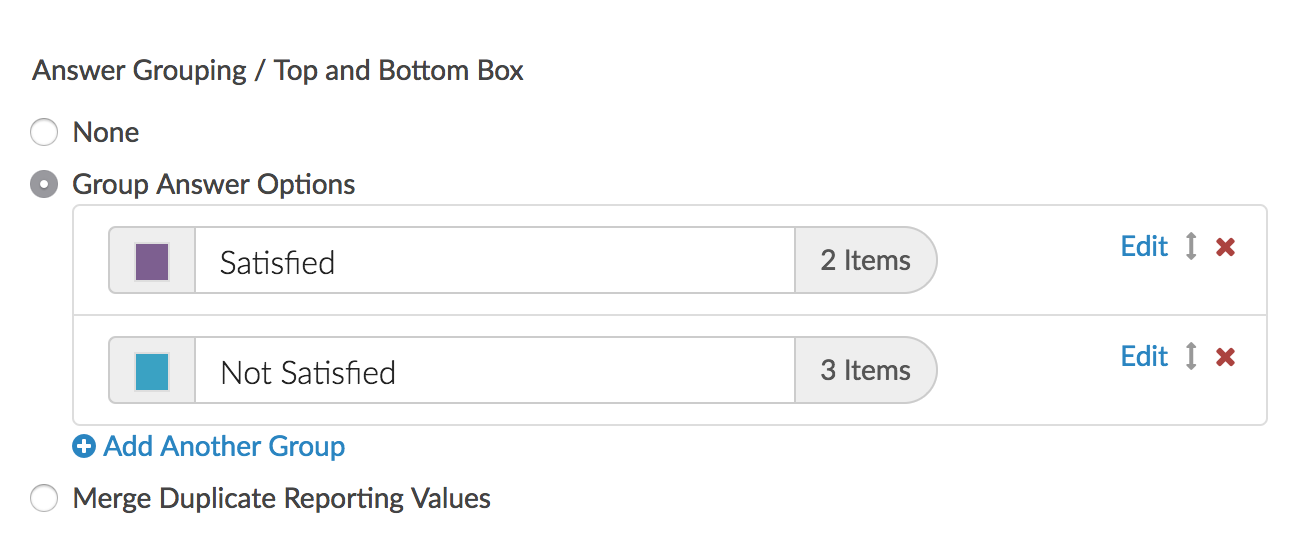
The Answer Grouping feature allows you to group answer options for reporting purposes. This functionality allows you to do what is often referred to as "recoding" in data preparation parlance.
If you are looking to group answer options in your surveys check out our Grouping Answer Options in Surveys Tutorial.
A common use case for grouping answer options is Top and Bottom Box Scoring but this feature can be used for all sorts of analysis and reporting needs.
There are two methods for grouping answer options in Alchemer Standard Reports:
- Answer Grouping/Top and Bottom Box - create groups/categories and choose the answer options that fall into each category.
- Merge Duplicate Reporting Values - automatically combine answer options within a single question that have identical reporting values.
The main benefit of using the Answer Grouping tool over the Merge Duplicate Reporting Values option is that Reporting Values do not need to be duplicated. There are a number of implications of duplicating reporting values.
Group Answer Options
The Answer Grouping / Top and Bottom Box tool is available in Standard Reports for the following question types:
Grouping - Compatible Questions
- Radio Buttons
- Radio Button Grid
- Rating (Likert Scale)
- Checkboxes
- Checkbox Grid
- Dropdown Menu
- Dropdown Menu List
- Image Select (single & multi)
- Net Promoter Score® (NPS® questions are grouped by default. The grouping cannot be changed but the color associated with the group can be!)
- When you are ready to report on your results for one of the compatible questions, go to Results > Reports and create a Standard Report (or access an existing one).
- Locate the reporting element for the question for which you wish to group answer options and click Layout & Options.
- Scroll down to the Answer Grouping / Top and Bottom Box section. The None (default) option will be selected.
- Click on the option to Group Answer Options.
- You will be presented with a Group Name field. Enter the category name for your Top/Bottom Box here e.g. Satisfied. This name is what will appear as the label on your chart.
- Click Edit to select the answer options that will be grouped together.
- Use the color selector to customize the color for the category. This will be the color of group's the pie slice or bar in the report.
- Click to Add Another Group to categorize any remaining items. You can add as many groups as there are answer options in your question. If needed, groups can be rearranged by clicking, holding, and dragging the up/down arrow icon.
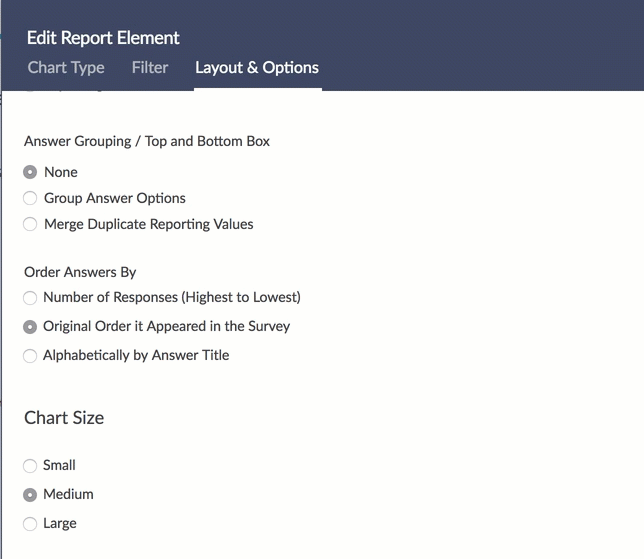
- Once you are done adding and customizing your groups, make sure to Save your report element.
Considerations when grouping answer options
- Once an option has been added to a group, it cannot be added to another group within the same report element.
- You can add as many groups as there are answer options in your question. If your question is a 5-point rating scale, you will be able to create up to five groups for that report element.
- Grouping Answer Options is a per-element setting. There is no global report setting.
Merge Duplicate Reporting Values
In order to use this method, you must customize multiple answer options within a question to have the same reporting values.
Review the implications of duplicating reporting values.
- When adding your answer options define custom Reporting Values; give any options you wish to group together the same reporting value.
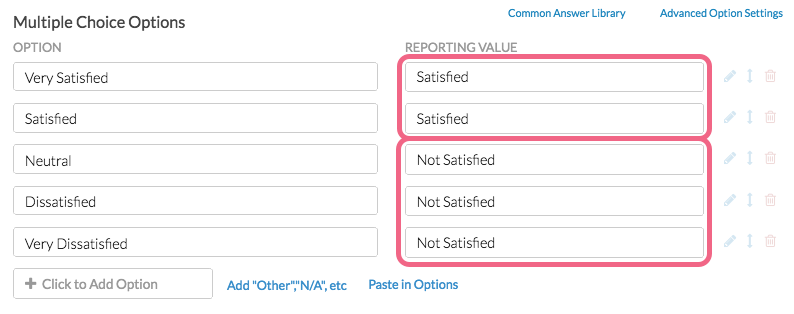
- When you are ready to report on your results, navigate to Results > Reports and create a Standard Report (or access an existing one).
- Locate the reporting element for the question for which you wish to group answer options and click Layout & Options.
- Scroll down to the Answer Grouping / Top and Bottom Box section. The None (default) option will be selected. Click on the option to Merge Duplicate Reporting Values and Save.
Your reporting element will now display your data grouped according to the Reporting Values that you provided.
Merge Duplicate Reporting Values at the Report Level
If you've set up multiple questions with duplicate reporting values you can merge reporting values at a report level by selecting Report Options at the top right of the report. Under Answer Options > Answer Grouping select the option to Group answers with duplicate reporting values and click Save.
Duplicate Reporting Value Considerations
- Question Logic and Page Logic are based on reporting values. As such, if multiple answer options have identical reporting values, any logic based on those options will not work as expected.
- If you are planning to use a CSV/Excel Export of your raw data, please note that only the Reporting Values that you specified will be available. If this is the case is a deal breaker use the Group Answer Options tool to group your answer options.
- Using questions that use duplicate reporting values in Quota setup can result in an incorrect number of responses being collected.
- We discourage changing reporting values in live surveys that have already collected data. Make sure to only implement this solution in new surveys. Learn more about Making Changes to Live Surveys.
Grouping Example: Top and Bottom Box Scoring
Top and Bottom Box Scoring (also referred to as Top Box, Top 2 (or 3) Box Scores) is a very common way of reporting and analyzing scale questions. The top/bottom boxes are the highest and lowest ratings on a scale question.
For example, if you were to think of a 5-point Likert Scale as being vertically arranged, with the most positive possible rating on the top and the most negative rating on the bottom, the top box scores are the highest rating points on the scale and the bottom box scores are the lowest rating points.
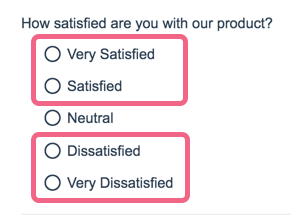
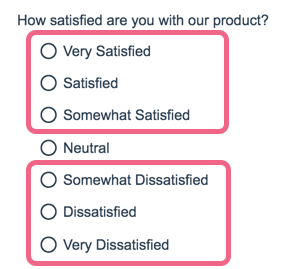
Using the Answer Grouping/Top and Bottom Box tool you can group your answer options to achieve Top Box Reporting.

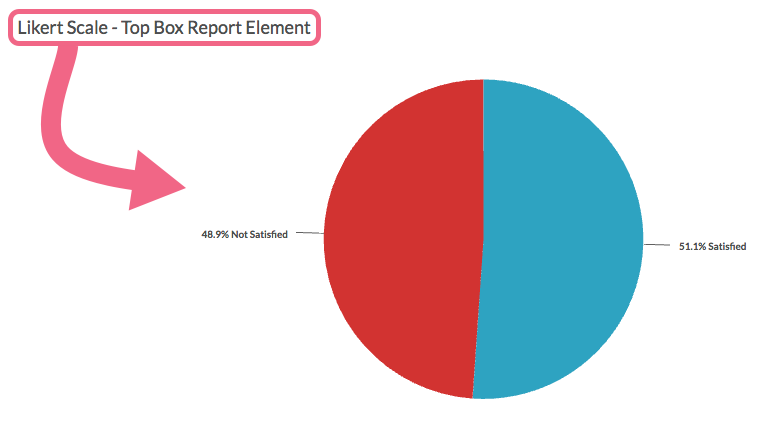
Learn how to set this up in our Top Boxing Tutorial.
Grouping Example: NPS® Questions
When using the Net Promoter Score® (NPS) question, responses are automatically grouped as Detractors, Passives, and Promoters. As such, within a Standard Report your NPS questions will use the Group Answer Options feature by default (grouping Detractors, Passives, and Promoters appropriately).
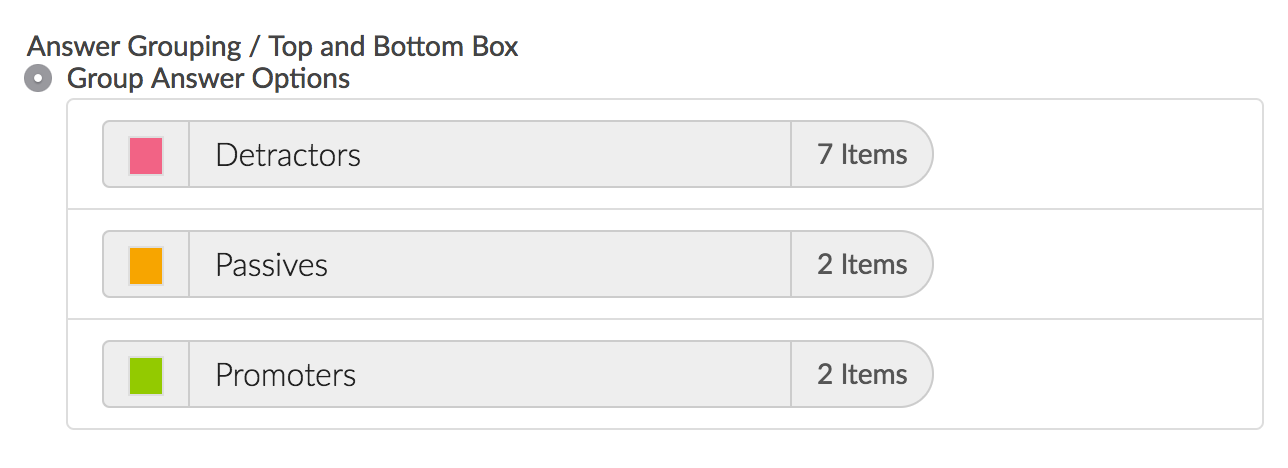
Using the Answer Grouping tool, you can update both the colors of your NPS reporting element, should you prefer something other than Alchemer's defaults. To do so, click on each category's color selector to choose a different color for representing that category in your report.
If you wish to change the category name you can do this within the Text and Translations tool. Learn more about changing categories in our Net Promoter Score Tutorial.
Net Promoter®, NPS®, NPS Prism®, and the NPS-related emoticons are registered trademarks of Bain & Company, Inc., Satmetrix Systems, Inc., and Fred Reichheld. Net Promoter Score℠ and Net Promoter System℠ are service marks of Bain & Company, Inc., Satmetrix Systems, Inc., and Fred Reichheld.

